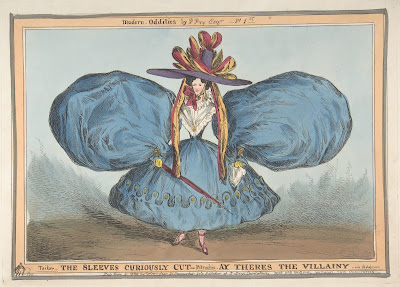Unpacking from another "Underwear Under There" presentation this afternoon left me thinking about several things...so I thought I'd write a little blog post on both my fashion talk and related personal observations.
 |
| Display of reproduction Regency Era underthings. |
For me, the making and wearing of historical fashions has become more than simply an interest and hobby to pursue in spare time. It's become my focus at both school and work, and a passion I hope to turn into a full-time career. Nothing makes me happier than sporting the latest creation, or researching and sharing new discoveries with others. Through this niche, I've met so many interesting people (both online and in person), formed friendships, gained confidence in public speaking and acceptance for my unusual interests (and odd appearance to the general public haha!)
Over the past few years, I've been very fortunate to have several opportunities to develop and teach historical fashion education programs, including a walking tour, summer camp and general practice in front of school and senior groups, scouts and the general public. I've started recording notes and folders for different presentations, in hopes that I can continue doing and expanding on these offerings. I'd love to find more outlets and audiences, and am always open to suggestions - so please, suggest away!
I enjoy working with children of all ages:
 |
| Photograph credit: Ruby Foote, GCV&M photographer |
And even dressed and undressed for a college fashion history class:
But, in the meantime, I'll be happy with my walking tour at the Genesee Country Village: "The Underwear Under There." The first time I gave this presentation or "gathering" as our museum calls it was last summer. In one hours time, visitors and I make three stops - first to the Dressmaker's Shop, then the Foster-Tufts House, and Romulus Female Seminary - tracing the dramatic changes in fashion and undergarments necessary to create the silhouettes during first half of the 19th century.
At each building, I opened with the fashion tastes of that decade and a brief historical context. It really helped to have the interpreters there to model the silhouettes from the outside, then to talk through the underwear layer by layer with reproduction examples. To keep things entertaining and engaging, I added period anecdotes, fashion plates, satirical cartoons and a slew of terribly punny jokes, as well as passed around a majority of the undergarments. People of all ages enjoyed trying on the sleeve plumpers and lifting the weight of several petticoats all at once. (I even let several interested visitors try on my corsets and cage crinoline afterwards to bust some common myths!) Finally, I took questions throughout the tour and referred to other attractions and events in the village, including the Susan Greene Costume Collection.
Pictures from last year's walking tour:
 |
| Every visitor receives a day sheet at admissions with special programs, highlights and other information. |
 |
| I left a sign with a few items in the Dressmaker's Shop to interest visitors. The interpreters were also so kind to advertise it! |
Pictures from yesterday's walking tour: I really hope I'll get to do it again, soon! And maybe I'll convince a friend or the sister to take a few pictures during a future tour...
 |
| A new description and time! |
For those who are interested, here's my outline:
1800s: Regency (named for the Prince of Whales and later King George IV) or Empire in France (after Napoleon crowned himself in 1804)
- Neoclassical revival and the popularity of the "little, white Regency dress"
- Examples of undergarments: clocked stockings, chemise or shift, short stays, strapped or bodiced petticoats
- Fashion plates
1830s: Romantic Era (named for the artistic and literary movement that focused on emotion over industrialization)
- Transitional period, Gothic influences, popularity of fashion magazines (like Godey's, Peterson's, etc.)
- Examples of undergarments: stockings, chemises and split drawers, long stays with wooden busks, sleeve plumpers, pockets, small supports and layers of tucked or corded petticoats
- Fashion plates and satirical cartoons - here are two of my favorites:
 |
| "Modern Oddities" by William Heath ("Paul Pry") Hand-colored etching, published June of 1829 (Image source: The MET) |
 |
| "The Toilet of a Modern Belle: Inflating a Lady" Hand-colored etching, published July of 1829 (Image source: The MET) |
1850s: Crinoline Era (named for the crinoline, of course!)
- Textile advancements like the Singer sewing machine, mass production and expansion of ready to wear clothing
- Examples of undergarments: chemise and drawers, stockings, corset with slot and stud busk, cage crinoline and petticoats
- Fashion plates
And last, but not least, I have to share this picture as a teaser for the next blog post: When I saw this other the day, there was a screen shot and much squeeeeeing!





No comments:
Post a Comment